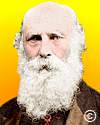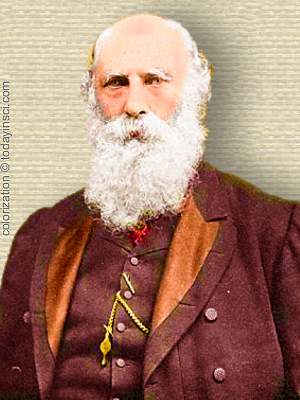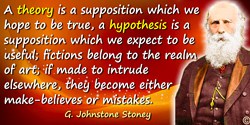 (source)
(source)
|
G. Johnstone Stoney
(15 Feb 1826 - 5 Jul 1911)
Irish physicist who identified a fundamental unit of electricity in electrolysis (Aug 1874), and subsequently coined the word “electron” for it. When J.J. Thomson discovered the particles in cathode rays, 23 years later in 1897 (which he called “corpuscles,” the name electron was also applied them.
|
XLIX.
Of the “Electron,” or Atom of Electricity.
from The Philosophical Magazine (Oct 1894)
Gentlemen,
[p.418] PROFESSOR EBERT, in his paper on the Heat of Dissociation in last month’s (September) Phil. Mag., says on p. 332 :— “Von Helmholtz, on the basis of Faraday’s Law of Electrolysis, was the first to show in the case of electrolytes that each valency must be considered charged with a minimum quantity of electricity, the ‘valency-charge,’ which like an electrical atom is no longer divisible.”
Now I had already twice pointed out this remarkable fact: first, at the Belfast meeting of the British Association in August 1874, in a paper “On the Physical Units of Nature,” in which I called attention to this minimum quantity of electricity as one of three * physical units, the absolute amounts of which are furnished to us by Nature, and which may be made the basis of a complete body of systematic units in which there shall be nothing arbitrary. This same paper was again read before the Royal Dublin Society on the 16th of February, 1881, and is printed both in the Proceedings of that meeting and in the Phil. Mag. of the following May.
[p.419] Professor Helmholtz’s announcement was made in his Faraday Lecture delivered on the 5th of April, 1881, subsequent to both the announcements I had made. See the Journal of the Chemical Society for 1881. The announcements as made by him and by myself are as follows :—
“Now the most startling result of Faraday’s Law is perhaps this. If we accept the hypothesis that the elementary substances are composed of atoms, we cannot avoid concluding that electricity also, positive as well as negative, is divided into definite elementary portions which behave like atoms of electricity. As long as it moves about on the electrolytic liquid each ion remains united with its electric equivalent or equivalents. At the surface of the electrodes decomposition can take place if there is sufficient electromotive force, and then the ions give off their electric charges and become electrically neutral.”
“And, finally, Nature presents us, in the phenomenon of electrolysis, with a single definite quantity of electricity which is independent of the particular bodies acted on. To make this clear I shall express ‘Faraday’s Law’ in the following terms, which, as I shall show, will give it precision, viz.:—For each chemical bond which in ruptured within an electrolyte a certain quantity of electricity traverses the electrolyte which is the same in all cases. This definite quantity of electricity I shall call E1. If we make this our unit quantity of electricity, we shall probably have made a very important step in our study of molecular phenomena.”
(Readers of my paper are requested to bear in mind that it was written so long ago that the Ampere was still understood to mean the electromagnetic unit quantity of electricity of the Ohm series. The term is now always applied to the unit current. Moreover the paper, having been written before C.G.S. units came into use, employs those which had been at an earlier date adopted by the Committee of the British Association on Electrical Standards, viz. the G.M.S., or gram-metre-second system.)
In this paper an estimate was made of the actual amount of this most remarkable fundamental unit of electricity, for which I have since ventured to suggest the name electron. According to this determination the electron=a twentiethet (that is 10‒20) of the quantity of electricity which was at that time called the ampere, viz.: the quantity of electricity which passes each second in a current of one ampere, using this term here in its modern acceptation. This quantity of electricity is the same as three eleventhets (3 × 10‒11) of the C.G.S. electrostatic unit of quantity.
[p.420] That determination was made twenty years ago, and is founded on the estimate I had previously announced in 1867 of the number of molecules present in a gas, viz.: 1018 in each cubic millimetre of a gas at standard temperature and pressure (see Phil. Mag. for August 1868, vol. xxxvi. p. 141).
An estimate of this same remarkable unit of electricity was made in 1891 by Professor Richarz, as quoted by Professor Ebert (see p. 335 of the September number of the Phil. Mag.). His determination makes the electron = 12·9 eleventhets (12·9 × 10‑11) of the C.G.S. electrostatic unit. This appears to be in sufficiently satisfactory agreement with my previous determination, having regard to the amounts of the probable errors of some of the data.
Finally, in 1891 (see Transactions of the Royal Dublin Society, vol. iv. p. 583), I called attention to the fact, which Professor Ebert appears also to have noticed in 1893 (see footnote on p. 335 of the September number of the Phil. Mag.), that the motions going on within each molecule or chemical atom cause these electrons to be waved about in the luminiferous aether, and that in this constrained motion of the electrons the distinctive spectrum of each kind of gas seems to originate: since lines in the spectrum will be furnished by each term of the Fourier’s series which represents the special motion of each electron (see Transactions of the Royal Dublin Society, vol. iv. 1891, p. 585). In fact the only other conceivable source of these spectra is excluded, viz., Hertzian undulations consequent upon electric discharges within or between the molecules. This is because these undulations, if they exist, must consist of waves of far too high frequency to produce lines that can be visible, or even that could be situated within any part of the spectrum that has been reached by photography—a circumstance to which my attention was called by Professor FitzGerald. They cannot, therefore, be the cause of any part of the known spectra of gases.
Yours faithfully,
G. Johnstone Stoney.
8 Upper Hornsey Rise, N.
September 4, 1894.
* The two other units being (1) the “Maxwell” of velocity, that velocity which connects electrostatic with electromagnetic units in a medium of which the inductive capacity is unity, and which, under the electromagnetic theory of light, is also the maximum velocity of light; and (2) the “Newton of gravitation, that coefficient of universal gravitation of the amount of which Professor Boys has lately made so accurate a determination.
- Science Quotes by G. Johnstone Stoney.
- 15 Feb - short biography, births, deaths and events on date of Stoney's birth.
- Obituary for George Johnstone Stoney from Proceedings of The Royal Society (1912)






